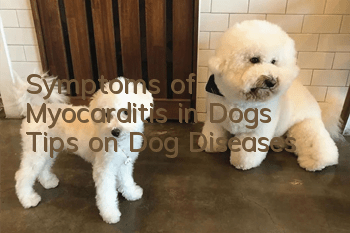Symptoms of Myocarditis in Dogs Tips on Dog Diseases

Symptoms of myocarditis in dogs
1. Acute myocarditis often begins with symptoms of myocardial excitement, which include rapid and substantial pulse, hyperpalpitations, and enhanced heart sounds.2. After the sick dog exercises for a while, the heart rate increases rapidly, and it can continue for a long time even if the exercise stops.
3. When the dog’s myocardium suffers from malnutrition and degeneration, the main symptoms are heart failure.
4. When the compensatory adaptability of the heart is lost, the sick dog's mucous membrane will become cyanotic, breathing will be highly difficult, the veins on the body surface will be dilated, and the extremities of the limbs, chest and abdomen will be edematous.
5. Chronic myocarditis manifests as weakness, dyspnea, tachycardia, weak heartbeat, irregular rhythm, often accompanied by systolic murmur.
6. Dogs with severe myocarditis lose their appetite, become depressed, become comatose, and eventually die suddenly due to heart failure.
Causes of myocarditis in dogs
1. Myocarditis of varying degrees can usually be caused in the acute phase of infection by viruses or other pathogens, such as canine distemper, canine parvovirus, leptospira, Infectious hepatitis, influenza.2. Certain parasitic diseases (such as Toxoplasma gondii, canine nausea filariasis) can also cause myocarditis.
3. Toxic diseases (such as carbon monoxide, heavy metals, phenols, organophosphorus, anesthetic drugs, etc.) can directly damage the myocardium, leading to myocarditis or myocardial degeneration.
4. In addition, sepsis, sepsis, allergies, rheumatism, anemia, etc. can all cause myocarditis.
Treatment measures for canine myocarditis
The treatment principles for canine myocarditis are: reduce the burden on the heart, enhance myocardial nutrition, improve myocardial contractile function, and treat the primary disease.1. Strengthen care: Sick dogs should rest quietly, stop training and working, avoid excessive excitement and exercise, and limit excessive drinking of water.
2. Promote myocardial metabolism: Adenosine triphosphate 15 to 20 mg, coenzyme A 35 to 50 units or inosine 25 to 50 mg can be injected intramuscularly, 1 to 2 times a day. Or add 15 to 30 mg of cytochrome C to 200 ml of 10% glucose solution and inject it intravenously.
3. Symptomatic treatment: In cases of severe dyspnea, oxygen can be given. For dogs with oliguria and obvious edema, diuretics can be used.
Random articles
- What do dogs eat to protect their stomach? It is important to protect their stomach and treat gastrointestinal diseases in dogs.
- How to tell if your dog is fat? Is your dog overweight?
- Will your dog catch a cold if you blow the air conditioner? What should you do if your dog catches a cold if you blow the air conditioner?
- What should you pay attention to when your dog drinks water? Don’t be careless when it comes to your dog’s drinking water.
- The dog's mouth bites and shakes. Why does the dog's mouth occasionally shake and bite?
- How to cut a dog's hair? Do you know how to cut a dog's hair correctly?
- Can dogs eat raw eggs? Why can’t dogs eat egg whites?
- Common Dog Problems in Summer How to Deal with Different Dog Problems
- How to keep dogs away from skin diseases. If you do this, will you see if your dog will still be infected with skin diseases?
- What causes anorexia in dogs? Dogs will become anorexic due to lack of exercise. Hounds run at least 5KM every day.



